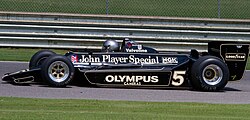Lotus 79
 |
|||||||||||
| Category | Formula One | ||||||||||
|---|---|---|---|---|---|---|---|---|---|---|---|
| Constructor | Team Lotus | ||||||||||
| Designer(s) |
Peter Wright, Colin Chapman, Geoff Aldridge, Martin Ogilvie, Tony Rudd |
||||||||||
| Predecessor | Lotus 78 | ||||||||||
| Successor | Lotus 80 | ||||||||||
| Technical specifications | |||||||||||
| Chassis | Aluminium monocoque | ||||||||||
| Suspension (front) | Double wishbone, inboard spring/damper. | ||||||||||
| Suspension (rear) | Parallel top links, lower wishbones, twin radius arms, outboard spring/damper. | ||||||||||
| Engine | Ford-Cosworth DFV, 2993cc V8, naturally aspirated, mid-engined, longitudinally mounted | ||||||||||
| Transmission | Hewland FG 400, 5-speed manual | ||||||||||
| Fuel |
Valvoline (1978) Essex (1979) |
||||||||||
| Tyres | Goodyear | ||||||||||
| Competition history | |||||||||||
| Notable entrants |
John Player Team Lotus, Martini Racing Team Lotus, Team Rebaque |
||||||||||
| Notable drivers |
|
||||||||||
| Debut |
1978 Belgian Grand Prix, Zolder. |
||||||||||
|
|||||||||||
| Constructors' Championships | 1 (1978) | ||||||||||
| Drivers' Championships | 1 (Mario Andretti, 1978) | ||||||||||
The Lotus 79 was a Formula One car designed in late 1977 by Colin Chapman, Geoff Aldridge, Martin Ogilvie, Tony Rudd and Peter Wright of Lotus.
The Lotus 79 was the first F1 car to take full advantage of ground effects aerodynamics, pioneered in its immediate predecessor, the Lotus 78. The undercar pressure problems in the 78 were resolved with the 79, with further design work on the venturi tunnels under the car, which allowed the low pressure area to be evenly spaced along the whole of the underside. This was achieved by extending the rear bodywork to a point inside the rear wheels, allowing the underside to extend further back, instead of ending abruptly in front of the rear wheels as on the 78. As a result, the rear suspension was also redesigned to allow the air to exit the rear more cleanly than on its predecessor. This allowed a smaller rear wing to be designed, causing less drag. When the car first appeared, the upper bodywork was steeply raked and featured "Coke bottle" sidepods. After work in the wind tunnel, these features were found to be unnecessary, as the car generated so much downforce anyway. These features were, however, later incorporated into the Lotus 80. In all, five chassis were built during the design's lifetime, with the prototype 79/1 being sold to Héctor Rebaque to race as a privateer entrant.
The car was powered by the Ford Cosworth DFV and constructed of sheet aluminium honeycomb, specially strengthened for the pressures exerted on the car by the ground effect. The fuel tank was one single cell behind the driver, as opposed to separate fuel tanks as on the 78. This had the advantage of increasing fire protection and moving the centre of gravity to the middle of the car, helping cornering and braking. The 79 was also the first F1 car to be designed using computer design aids. In fact, it was the first F1 car to use computers to analyse it in the pits on race weekends.
...
Wikipedia
